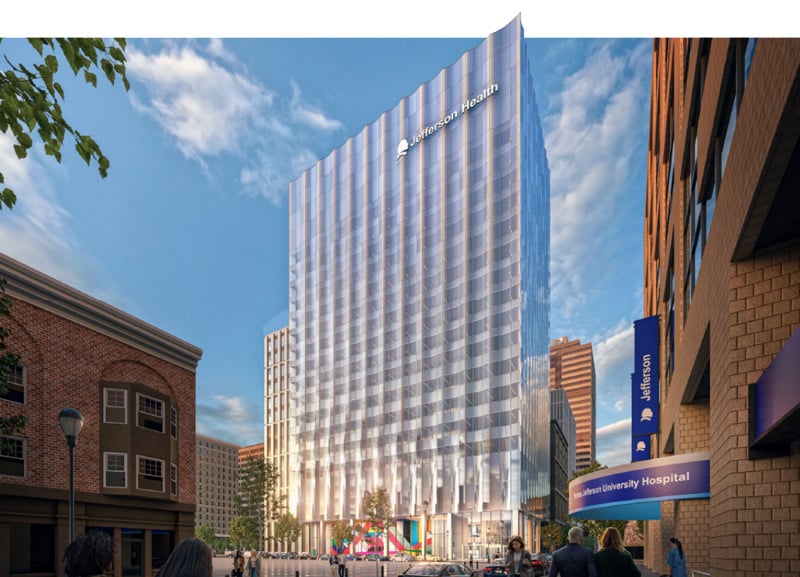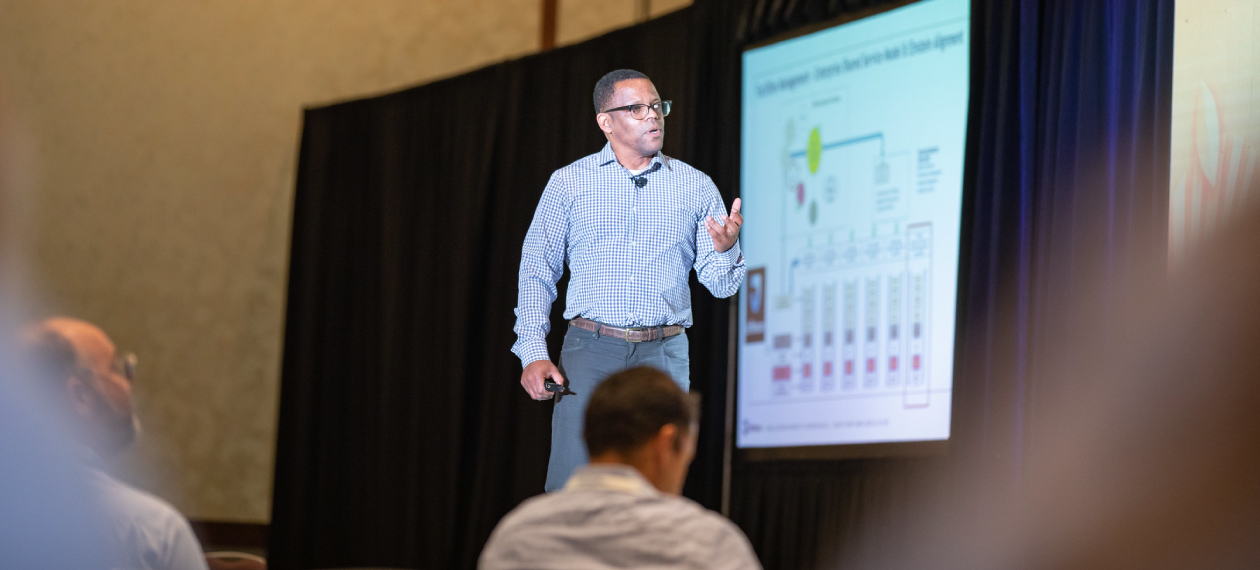In 2019, Clayton Mitchell joined Thomas Jefferson University and Jefferson Health in the midst of a period of great change. Through a series of mergers and consolidations beginning in 2014, Jefferson evolved from a health sciences university to a 14-hospital regional health system. When Mitchell came onboard as its new SVP of real estate and facilities, his mission was to keep pushing Jefferson forward.
He’s already made short work of that objective, drawing on his experience as executive director of national facilities services at Kaiser Permanente—and before that, as a director in the Naval Facilities Engineering Systems Command—to launch Jefferson’s largest capital project yet: the 20-story, high-tech Specialty Care Pavilion in the heart of Philadelphia’s Center City. Now he’s continuing his work by building a transformational real estate and facilities team, ready for whatever challenges the future might bring as Jefferson continues to grow as a health system.
Rendering of Jefferson Health's Specialty Care Pavilion.
At a recent HealthSpaces event, Mitchell discussed some of the lessons he’s learned and how other real estate and facilities leaders can apply them, too.
Capability, Capacity, and Coachability
One key pillar of Jefferson’s transformation strategy is a future-minded digital approach. The goal is to build what Mitchell described as a technology-enabled enterprise: one where technology is integrated into every aspect of operations, improving security and building controls while reducing energy costs and enhancing ROI. Then there are the labor implications. By leveraging technology, Mitchell said, businesses can create the workforce of the future largely by recruiting from neighboring or even unrelated industries—and trusting that competent workers, properly trained and technologically equipped, will be able to excel.
For his part, Mitchell looks at three qualities when he’s hiring: capability (“Can you do this job that we need today?”), capacity (“Can you not only do this job, but do you have the capacity to grow and do more?”), and coachability (“Can I coach you in this environment?”). These guideposts have yet to let him down. Five of the last seven manager-level roles he hired had no healthcare experience, Mitchell said, and they’re all “killing it.”
In 2020 alone, Jefferson staffed a fully functional corporate real estate team, built out its recruitment pipeline in Thomas Jefferson University, beefed up the mentorship programs essential to its internal leadership pipeline, and brought needed diversity to its executive and management teams. Another important transformation was at the organizational level, giving more specific roles to project managers who previously had broad horizontal portfolios.
“We’re at this place where we have to naturally break off functions,” Mitchell explained. “For us that meant creating a director of facilities contracts—to treat contracts as a more professional type of capability—and then refocusing our project managers in those places where they can bring the most value.” Looking forward, he expects those project managers to evolve into program managers as the organization increasingly leverages its vendors for more complex projects.
“It paid for itself probably 20 times over.”
Workforce development is a long game, but big investments pay early dividends. “Our real estate team, in terms of how we grew it, brought back $13 million of value, real value,” Mitchell reflected. He originally expected Jefferson’s new VP of real estate role to pay for itself twice over, but that estimate turned out to be a little low. “It paid for itself probably 20 times over.”
Forging the Pathway to Transformation
Call it Jefferson’s Law of Thermodynamics: the more transformative you are, the more transformative you can be. In just two years Mitchell’s team has built up deep reserves of performance and relationship currency, reshaping Jefferson from the inside out. The results are clear. “There’s no decision that gets made in Jefferson, now, that doesn’t include some call into somebody within real estate and facilities for a thumbs-up,” he said. “They respect what we deliver and how we can position them for success, from a real estate and facility standpoint.”
For Mitchell, the pathway to transformation requires a clear, sound vision. “Where there is no vision, there is no hope,” he intoned in a Shakespearean dramatic flourish. Executing that vision requires strong talent, and recruiting strong talent increasingly means looking outside healthcare. “It’s other industries that we need to pull into our industry to help us move forward,” he said.
Before your team can execute your vision, you first need to communicate it to a variety of stakeholders in their native languages: engineers, architects, executives, even policymakers. “You need a plan of action that’s communicated in the lexicon of the audience,” Mitchell explained.
This is where those reserves of performance and relationship currency come in handy. For Mitchell, they helped his team push for and obtain a city ordinance restricting development around Jefferson to protect its helipads—a feat of politicking pulled off in less than a year. “No fanfare from the public, no violent pushback or anything of that sort," he recalled. All it took was "working the relationships and speaking the lexicon of the audience we were dealing with.”
Putting People First
The final steps on Mitchell’s pathway to transformation are stalwart values and guiding principles. For Jefferson, those are Putting People First, Doing the Right Thing, and Being Bold and Thinking Differently. One simple story Mitchell told illustrated all three.
When the pandemic hit, Jefferson’s CFO told him there wouldn’t be any layoffs at the company “And I was like, wait a minute—I’m talking to the CFO, and he’s talking about not having layoffs, and there’s a potential $300 million tsunami that’s about to hit us,” he recalled. “He said, ‘We’re going to get through April. We’re going to get through May. And the objective is that we don’t have any layoffs—because if we really are putting people first, we’ve got to take care of our own.’”

Posted by
Collaborate with your Peers!
HealthSpaces is a community for people that plan, design, build and operate spaces where healthcare is delivered.
June 7-9, 2026 | Braselton, GA
Learn More




-4.png)
-Dec-09-2025-05-48-44-4379-PM.png)
-4.png)
-1.png)
-2.png)

Comments